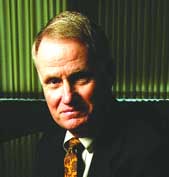Modern agencies have many systems for keeping in touch, but they don't talk to one another. In fact, surveying these modern tools of communications is a bit like attending a party where no one knows any of the other guests.There's the e-mail system, which employees can't access when all they have is a cell phone. There's the meeting calendar, which can't call people when schedules change. There's the phone system, which can't direct calls to where employees actually are. And there's instant messaging, which can't turn a chat into a more formal meeting.Clearly, what the party needs is a means of introducing these aloof systems to one another and getting the conversation going. Various vendors have been working to do this, using the term unified communications to describe their labors.'Unified communications is the next step in the convergence of telecommunications and IT, bringing together technologies like computers, cell phones and PDAs,' said Chuck Saffell, chief executive officer at Nortel Government Solutions, a division of Nortel Networks.Unified communications can take many forms: phone and data traffic on the same IP data network, consolidating e-mail and instant messaging, integrating office applications with telephony, linking Web and video conferencing, voice access to e-mail. It all depends on what you're trying to do.Marty Parker, principal at Communications Perspectives and co-founder of information clearinghouse UC Strategies, said he sees unified communications as divided into three elements: voice communications, desktop software and business applications.Voice communications includes ordinary telephony, voice mail, call routing and conferencing.Desktop software includes everyday office applications, such as word processing, spreadsheets, e-mail and instant messaging, and even more advanced offerings such as speech recognition and sound recording.Business applications include all the packages and databases that agencies run to do their jobs.In this view, each unified communications system involves interoperation between at least two of the three elements, with each solution emphasizing different combinations of the three.For example, a recent initiative between Nortel and Microsoft involves interaction mainly between voice communications and desktop applications. A Microsoft Word document might have an automatic telephone link to the document's author, for instance. Click the link, and you initiate a phone call to the author, saving the time of looking up the author's number and then placing the call. Indeed, a mouse-over of the author's name could indicate whether the author is even available or not, as with some instant-messaging systems. Such interoperation allows faster and simpler interaction.Cisco Systems and Avaya are teaming with IBM to integrate their products into unified offerings. Cisco also acquired virtual-meeting software provider WebEx for $3.2 billion. Oracle has acquired Siebel Systems and Telephony@Work for similar offerings.You can expect to see more links between major vendors. Such solutions save customers the trouble of figuring out how to accomplish the same thing themselves.'The goal of unified communications is to integrate communications to optimize business processes,' Parker said. Typical objectives include lowering cost, speeding processes and improving customer satisfaction. Unified communications can remove manual or repetitive steps from an operation. For example, an automated call-routing system can reduce the number of live operators.And unified communications can be more sophisticated. A 'find me' or 'follow me' system can route calls to employees wherever they may be. A rule-based process can use information ' such as who is calling, the number they're calling, and what day and time it is ' to connect the caller with the right person in the right place. This becomes more important as workers become increasingly mobile, working in remote offices, telecommuting or traveling. 'The result is a happier caller,' Parker said.'More complex solutions are possible, but require changing the business process itself,' said Melanie Turek, principal analyst at Frost and Sullivan. Suppose an agency needs to order 1,000 widgets. The procurement software knows that this large a purchase requires approval. A unified communications system could identify the person necessary for approval, find out where that person is and send them an instant message that they could click to approve. Such solutions can expedite decision-making.Agencies can use unified communications to improve communications with citizens, among employees of the same agency, between agencies, or with business suppliers or contractors. Agencies could also eliminate manual parts of a procedure to lower costs, speed the procedure or spare an employee the drudgery of repetitive tasks.Many agencies have employees who work out of the office ' performing inspections, appearing in court, traveling to meetings ' but who still must stay in touch.Unified communications can provide two-way communication in a variety of different modes. 'Voice access to e-mail is useful in itself and can become the basis for a range of collaboration tools,' said Susan Eustis, president of WinterGreen Research.This connectivity between people can be high-level or low-level. 'Requirements for intra-agency communication can be simpler with unified communications,' Turek said. Mandates for continuity of government and robust service also are more achievable using the interoperation of unified communications.Parker suggests that the first step in implementing unified communications is to identify processes to improve. Questions to ask include: For example, automated call centers can improve the process of contacting the right people. Software can decide, from the number called, who is the best person to handle the call, then route the call to that person. This simplifies the interaction for the caller and saves time getting the situation resolved; the improved communication improves this process.To implement unified communications solutions, different components are needed, depending on the situation. For example, a solution could involve hardware, software, a database of information, a directory of personnel or a combination of those.In fact, many pieces of the solution may already exist in an agency: phones, e-mail, calendaring software and employees using instant messaging. 'Ultimately, the network is the most important component, since it must be highly available and resilient,' said Brent Byrnes, regional manager for unified communications at Cisco's Federal Segment.Now that major vendors are offering unified communications components, it's possible to select commercial products without creating them from scratch. The advantage is that the desired links already exist. The disadvantage is that you may need to figure out how to get all the pieces to play together. Suppose the solution includes new desktop software ' but you already have desktop software you like. What if one attractive solution includes voice and desktop, and another solution includes desktop and database: Will the pieces play well together? 'Agency administrators will need to consider several part solutions,' Parker said.One downside is cost, though at least some expenses can be partially mitigated. Converging phone and data networks, for example, will ultimately save money in maintenance and support. 'If phones are moving to the data network, you don't need new phones,' Turek said. In one sense, there's no new cost for hardware, just new responsibility for the existing hardware.Parker suggested that agencies act now, and straighten it out later. 'You don't have to swap out your PBX: there's plenty of low-hanging fruit to harvest with existing hardware,' he said.'Leverage your existing system as much as possible,' proposed Siafa Sherman, director of technology at Nortel Government Solutions. For example, many agencies have video telephony systems that could also carry voice or data traffic, Byrnes said.In the long term, agencies can analyze their own orientation ' voice, desktop or application ' and begin long-range planning. 'Agencies can take advantage of any changes ' new building, new office, new hardware ' to move into unified communications,' Turek said.Turek reports seeing a progression of adoption. Few companies are deploying everything: They may start with voice over IP, then start thinking about what else they can do with the technology. 'It's a lot like e-mail originally: There was initial resistance, but now everyone uses it.'Government agencies have special considerations that business enterprises may not share. Security and privacy concerns may require encryption, authorization and authentication features. 'Having only one network to secure for voice, video and data actually simplifies security,' Byrnes said. Archiving also could be necessary as part of the solution ' and is much easier with everything running over one data network.A key to unified communications interoperability is emerging standards. The Computer Supported Telecommunications Applications standard is 10 years old, and most systems support it. The Session Initiation Protocol is a newer protocol that has the potential to surpass CSTA in capabilities, including Internet telephone calls, multimedia distribution and multimedia conferences. A ratified version of SIP is now available.Similarly, using open, rather than proprietary, technologies will ensure ease of connections as your solution develops. Siemens, for instance, has an open service-oriented architecture for its products. New products should crystallize around the new standards.Still, unified communications has a long way to go to reach general acceptance. 'Most technologies are not penetrating at this time. We're seeing single digits for presence,' Turek said. But the party could just be getting started.
'Unified communications is the next step in the convergence of telecommunications and IT, ' said Chuck Saffell, CEO at Nortel Government Solutions.
Rick Steele
- How does a communications channel impact this process?
- Who uses this process?
- How do we want to improve it?
Edmund X. DeJesus is a freelance technical writer in Norwood, Mass. (dejesus@compuserve.com).







